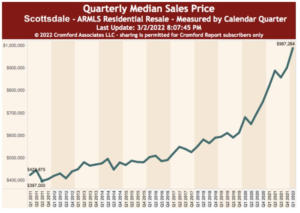Suburban property values can surge along with student opportunity
(reimaginED) – I’ve heard that advocates of open enrollment reform are encountering opponents who claim that if you allow open enrollment, then suburban property values will go down.
Scottsdale,…

(reimaginED) – I’ve heard that advocates of open enrollment reform are encountering opponents who claim that if you allow open enrollment, then suburban property values will go down.
Scottsdale, Arizona is one of the most active suburban choice areas in the country and a hotbed for open enrollment. In examining the record in Scottsdale, benefits are easy to find, and the theorized harms have failed to materialize.
Arizona has a usually active choice environment, with a majority of K-8 students in the Phoenix metro area attending a school other than their zoned district option. Arizona lawmakers passed open enrollment and a robust charter school statute in 1994 and began passing private choice legislation in 1997.
Arizona’s charter sector is both inclusive and diverse across communities, which is to say, unlike many states, it includes suburban communities. This is crucially important, as it encourages suburban districts like Scottsdale to participate in open enrollment.
Scottsdale Unified has campus capacity to educate 38,000 students, but currently has closer to 20,000 students. Many factors influence enrollment, including real estate prices, fertility trends, and the availability of other school options.
Nine thousand Unified Scottsdale students live within district boundaries and go to schools in other districts. Multiple charter schools have seen strong growth in the district, students can attend other districts through open enrollment, and on a more limited basis, aid to attend private schools can be accessed by families.
Scottsdale Unified, however, partially made up for the 9,000-student loss by enrolling 4,667 students through open enrollment during the 2019-20 school year. This graphic below, from a demographic report prepared for the district, depicts the location of enrolled students.
Altogether, almost one in four Scottsdale Unified students live outside district boundaries. Did the opening of all those charter schools and the lowering of the gate for open enrollment damage property values in Scottsdale?
Apparently not.

The diversification of K-12 opportunities may have helped property values in Scottsdale. It is certainly difficult to find evidence that property values have been harmed in any way.
Access to high-quality schools should not be rationed through the mortgage market, nor kept as an unnecessarily scarce commodity. Freeing educators to create new schools and families to select between them creates opportunities for families and teachers.
This article originally appeared on reimaginED.



